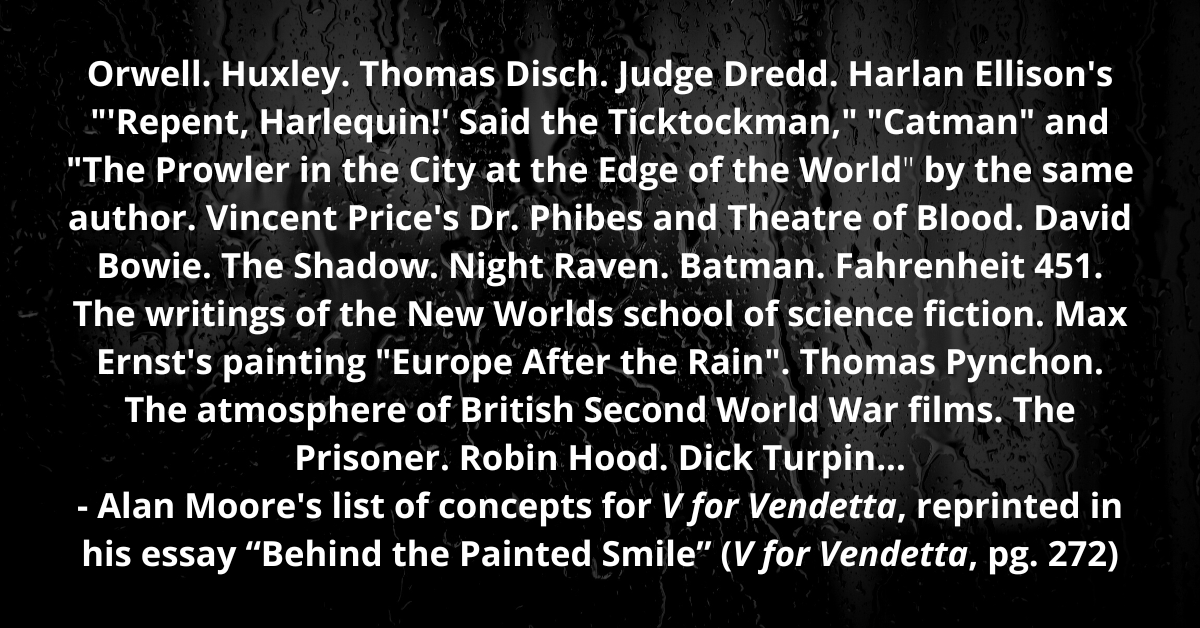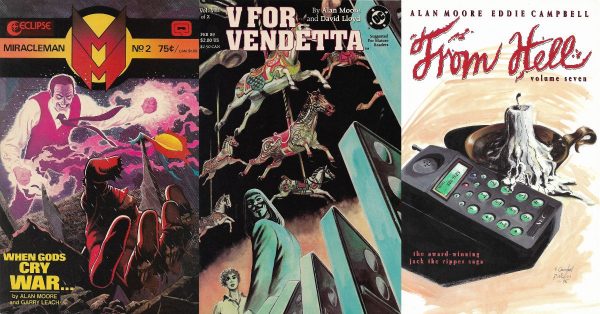Click here to read the previous installment.
… And I’m Going to Bring the House Down: Dystopia in V for Vendetta
Thus far, this series has suggested that many of Alan Moore’s great comic book works are the same core themes he explored while writing Captain Britain, just giving the ideas more room to develop. His work on the comic book series Miracleman can be seen Moore reusing the slash-and-burn approach he had used in Captain Britain (the hero is destroyed, remade anew) with more room to breathe. V for Vendetta can be seen as Moore taking the last act of Captain Britain and giving it more room to breathe.
As mentioned earlier, once Captain Britain returns to Earth, he discovers his nemesis has taken over Britain to make a fascist state where superhumans are rounded up. His nemesis, Jasper Johns, is depicted as a Thatcheresque rightwing politician. The story has dramatic images, but is ultimately too short to give much commentary on the Thatcher period, or be a particularly compelling dystopia.
V for Vendetta explores politics with more depth. It depicts a noirish future Britain, the then-future of 1997. Thanks to a liberal government winning the 1983 election, Britain had no nuclear arsenal and took a backseat in World War III. Once the missiles had been thrown, Africa and Europe were gone, and nuclear winter devastated Britain’s crops. A fascist group called Norsefire entered the picture, taking control and eliminating undesirables during the early 1990s.
Now, in 1997, everything seems to be under control. Authorities use a supercomputer named Fate to monitor everything, with swift action against anything that might create instability. Then, on November 5, a figure dressed like Guy Fawkes blows up Parliament.
The figure, who calls himself V, rescues teenager Evey Hammond from attackers the same night he explodes Parliament. Evey becomes a part of V’s year-long plan to overturn Norsefire.
The rest of the story cuts between V assassinating key individuals connected to his past and Evey’s slow transformation into a co-revolutionary. Meanwhile, detective Eric Finch goes on a long search to see if V’s victims tell him anything about V’s past. Finch’s search leads to stories about a concentration camp test subject who escaped after destroying the camp. But by that point, V has eliminated anyone who worked at the camp, so there’s no way to use that information to find him.
It’s clear that, like the hero Miracleman, V is bent on overthrowing a system. But what sort of system will he provide in its place? Anarchy. Anarchy is “the land of do-as-you-please… [not] the land of take-what you want. Anarchy means ‘without leaders’; not ‘without order…” (195).
V believes that people can rule themselves without supervision once he destroys the current regime. He sees humans as able to rule themselves peacefully, provided they learn to escape their acquired mental restraints.
“You’re in a prison, Evey. You were born in a prison. You’ve been in a prison so long, you no longer believe there’s a world outside.”
– V for Vendetta, 170
Thus, V for Vendetta makes explicit an idea that Moore had explored in Miracleman: his belief that liberty is paramount. However, in Miracleman he explored liberty by depicting a world where true anarchy might be possible. In V for Vendetta, he depicts a world that has traveled as far away from liberty as possible.
Dystopias are often a projection of the writer’s concerns about the world they live in. In an interview for BBC 4’s documentary series Comics Britannia, Moore observed, “with most of the future worlds in science fiction, you’re not talking about the future: you’re talking about the present.”
Neil Gaiman makes a similar argument in his introduction to the 60th-anniversary edition of Fahrenheit 451. Gaiman sees Bradbury’s story as “an ‘if this goes on…’ story,” extrapolating elements from 1950s American society (xii). The story has applicable concerns for today, but Gaiman sees its vision—a TV-obsessed culture, juvenile delinquency and potential nuclear war the key concerns—as essentially 1950s concerns, Bradbury taking his own period and recasting its concerns in a speculative form (xiii).
Similarly, V for Vendetta is an “if this goes on…” story about 1980s British conservative politics. In Captain Britain, Moore provided a hint that the dystopia he depicted was a commentary on what he feared the Thatcher government could create. In Miracleman, he takes a shot at Thatcher (showing her traumatized and silenced after superheroes make it clear her objections to market control will not stop them from running the world economy as they see fit). In V for Vendetta, Moore doesn’t feature Thatcher in the story or imply she’s a member of Norsefire. Instead, as he explains in Comics Britannia and elsewhere, he took his concerns about the riots and government force that occurred during Thatcher’s first term and extrapolated how it might escalate.
Consequently, the government in V for Vendetta may be seen as Moore’s concerns about what Thatcher’s government could lead to: a Britain ruled by conservative old boy networks frightened of homosexuality, diversity, and anything else that threatens their concept of Anglo-Saxon British cultural heritage. Notably, the only female figure in government is Fate, a supercomputer that Norsefire’s leader views as a matriarchal authority showing him what to do. Thatcher the AI.
In an extended version of the Comics Britannia interview, Moore outlines his solution to authoritarianism: anarchy. People governing themselves. He clarified in a 2005 interview that V’s methods aren’t meant to present a practical solution to emulate. However, V for Vendetta present an anarchist view to getting readers thinking about whether humans need government to manage society.
“I actually don’t think it’s right to kill people. So I made it very, very morally ambiguous. And the central question is, is this guy right? Or is he mad? What do you, the reader, think about this? Which struck me as a properly anarchist solution. I didn’t want to tell people what to think, I just wanted to tell people to think, and consider some of these admittedly extreme little elements, which nevertheless do recur fairly regularly throughout human history. I was very pleased with how it came together. And it was a book that was very, very close to my heart.”
– “A is For Alan,” 2005 interview for The Beat at Comic Con
In the same interview, Moore highlighted how the concerns raised in V for Vendetta remain relevant (in an age where computer surveillance on every street corner has become normal). Thus, like Fahrenheit 451, V for Vendetta has stayed topical beyond its period, yet firmly connected to its period.
The fact that V for Vendetta shows a hero who wears a Guy Fawkes mask means that Moore is not just building a dsytopia. He integrates literary or history elements in a way that many dystopias never explore. Like Miracleman, it can be read as a mythopoeic story. The Oxford Dictionary of Literary Terms defines mythopoeia as follows:
“The making of myths, either collectively in the folklore and religion of a given (usually pre‐literate) culture, or individually by a writer who elaborates a personal system of spiritual principles… The term is often used in a loose sense to describe any kind of writing that either draws upon older myths or resembles myths in subject‐matter or imaginative scope.”
While J.R.R. Tolkien did coin the term mythopoeia, he played a key role in advancing the term through his poem “Mythopoeia” and his mythopoeic Middle-earth writings. Drawing on ideas by Tolkien and other Inklings, the Mythopoeic Society defines mythopoeia as “literature that creates a new and transformative mythology, or incorporates and transforms existing mythological material.”
Moore incorporated many things into V for Vendetta (he lists about two dozen influences in his essay “Behind the Painted Smile”). However, using an image of Guy Fawkes took the story into truly mythopoeic territory. Moore took an image from a national mythology about a historical figure, and recreated the figure to make a new story.  In Miracleman, the myth-making involves characters who know they are creating a new mythology. V for Vendetta presents a different kind of myth-maker. V emulates Fawkes’ actions (blowing up Parliament) and wears Guy Fawkes’ face, but V creates a new mythic figure from these elements. V is not a Catholic terrorist planning to kill a member of the English monarchy. V is an anarchist terrorist planning to kill a whole government. Once that happens, V believes Britain will organize itself around a very different kind of government than fascists, democrats, or Catholic monarchs.
In Miracleman, the myth-making involves characters who know they are creating a new mythology. V for Vendetta presents a different kind of myth-maker. V emulates Fawkes’ actions (blowing up Parliament) and wears Guy Fawkes’ face, but V creates a new mythic figure from these elements. V is not a Catholic terrorist planning to kill a member of the English monarchy. V is an anarchist terrorist planning to kill a whole government. Once that happens, V believes Britain will organize itself around a very different kind of government than fascists, democrats, or Catholic monarchs.
Like the heroes in Miracleman, V uses his resources to create a state of anarchy. However, the fact that V for Vendetta makes its ideas about anarchy more explicit than Miracleman, without a godlike authoritarian in the background to keep the anarchic state going, means it is more philosophically consistent.
Whether or not anarchy is a workable system is debatable. Regardless, the fact that Moore uses dystopia to explore the same theme he explored in a utopian work (human freedom, the threat of authoritarianism), shows how to explore a theme from opposing perspectives. An author can create two different but complementary mythopoeias.
His next work discussed, the unconventional crime story From Hell, would take mythopoeia in yet another direction.
Return next week for Part 4 of Alan Moore’s Utopia, Dystopia, and Apocalypse.
Print Resources
Gaiman, Neil. “Introduction.” Fahrenheit 451: 60th Anniversary Edition. Simon & Schuster, 2013.
Moore, Alan and David LLoyd. V for Vendetta. DC Comics, 2005.

1 thought on “Alan Moore’s Utopia, Dystopia, and Apocalypse Part 3”